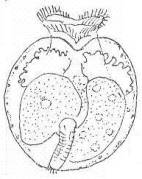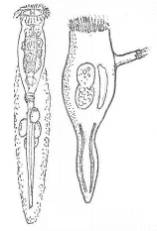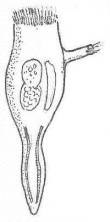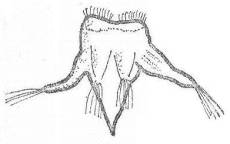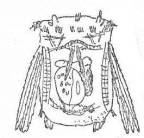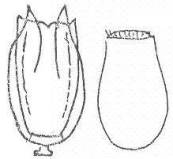Back to 25 a - Back to content
26 a. Lorica present, i.e. cuticle thickened to form a stiff shell
(lorica), which retain its shape well after preservation.
Lorica strongly flattened, circular in outline, foot opening
ventral, and foot ends in circle of cilia (se 16b)
Testudinella.................................................68
26 b. Lorica absent, i.e. cuticle thin and flexible, not usually
retaining its shape well after preservation. A gelatinous,
transparent case around foot and part of the
body............................................................27
27 a. Head more or less funnel-like. Foot long and slender, stalk-like.
Single animal in very transparent gelatinous case, usually
contracted. Most species littoral, few planktonic species.
Collotheca...................................................77
27 b. Head not funnel-like. Foot fairly stout. Solitary (Conochiloides)
or in colonies (Conochilus). Formalin-preserved specimens
separated from gelatinous case. Formalin-sugar-preserved specimens
still in gelatinous case, usually strongly contracted. Antenna
present, planktonic.
Conochilus (incl. Conochiloides).............................74
28 a. Body with spines or with blade-like or arm-like processes........29
28 b. Body without this................................................32
29 a. Cuticle thickened to form a stiff shell (lorica) retaining its
shape well after preservation. Often ornamented with ridges or
striations. Body with anterior and usually 1 or 2 posterior
spines. Planktonic.
Keratella....................................................49
29 b. Cuticle thin, transparent, not usually retaining its shape well
after preservation...............................................30
30 a. Body with 6 arms with setae. Nauplius-like. Planktonic.
Hexarthra....................................................73
30 b. Body with spines or feathers.....................................31
31 a. Body with long spines, 2 anterior and 1 (Filinia) or 2
(Tetramastix) posterior spines. Planktonic.
Filinia (incl. Tetramastix)..................................71
31 b. Body with 12 blades or feathers in 4 groups of 3 blades, 2 groups
dorsoventrally and 2 groups ventrolatterally. Planktonic.
Polyarthra...................................................66
to 32 a.
